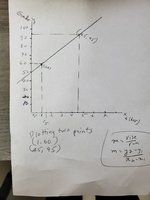eddy2017
Elite Member
- Joined
- Oct 27, 2017
- Messages
- 2,525
hi, i am asking the forum tutors to help me understand quickly how to set up an answer to questions like the one i am posting here.
a student recorded her grades on assessments in respect to the number of hours she studied for each assessment. which of the following equations is the linear equation of the function representing the data below. . let x represents the number of hours studying and y represent the assessment grade.
the answer given( without any explanation, of course) y=10x+50
i want to know how to get to this solution and understand the process.
thanks in advance for your help and for the forum.
Hours studying Assessment grade
1 --------------------60
1.5-------------------65
2.5-------------------75
3.5-------------------80
4.5 -------------------95
Ok, this is what i can do
i think i can take the table above and put in a x, y axis on a coordinate plane, where the x axis is going to represent the hours she spent studying, and the y axis is going to be the grades she got.
i have this already set up. what is the next step?.
eddy
a student recorded her grades on assessments in respect to the number of hours she studied for each assessment. which of the following equations is the linear equation of the function representing the data below. . let x represents the number of hours studying and y represent the assessment grade.
the answer given( without any explanation, of course) y=10x+50
i want to know how to get to this solution and understand the process.
thanks in advance for your help and for the forum.
Hours studying Assessment grade
1 --------------------60
1.5-------------------65
2.5-------------------75
3.5-------------------80
4.5 -------------------95
Ok, this is what i can do
i think i can take the table above and put in a x, y axis on a coordinate plane, where the x axis is going to represent the hours she spent studying, and the y axis is going to be the grades she got.
i have this already set up. what is the next step?.
eddy

